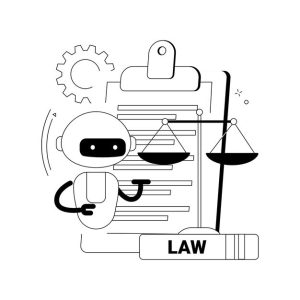It is necessary to understand that artificial intelligence or AI is changing industries like never before. It already plays an indispensable role in daily life and continues to expand its presence across industries. However, there is the dark side to this IT advancement in that it comes with a price when it comes to the environment. This is regarding power consumption since with larger and more complicated models the energy requirement increases significantly. Such a trend gives rise to many legal and regulatory issues. What response should be carried out by governments, companies, and individuals to the impacts that AI energy consumption causes? This asked what kind of legal frameworks will be seen to address these impacts. It is becoming more important to comprehend how the two fields: AI development and environmental law are compatible with each other to promote innovation.
The Energy Cost of AI Growth
Training the high level AI is very time and space consuming. For instance, in creating large language models such as GPT-4, one requires data centers that run for weeks if not months. In 2019, University of Massachusetts Amherst suggested that the creation of a single large AI model would release as much carbon dioxide as five cars in their lifetime totality. From then, models expanded in size and sophistication indicating that such projections may now be underestimations.
However, energy consumption at the operational level is only one part of the program. Large data centers are also resource heavy, as they require brute structures, steel, and copper to support the electrical and data systems in addition to vast amount of power for cooling systems. Additionally, the global development towards the use of AI technologies increases the rates of upgrades to the associated hardware, consolidating an ongoing process of production of electronics that negatively impacts the environment and the ever-growing demand for power.
Legal Frameworks Addressing Environmental Impact
Existing legal frameworks were developed with no regard for AI’s impact on the environment at the moment. But several theories that already existed could be applied or could be given a cue to address the energy usage of the sector:
- Environmental Protection Laws: General business acts on curbing carbon emission such as the U.S Clean Air Act or EU Green deal could apply to AI firms as well. There is an expectation, they will also need to declare their emissions and energy use, in a similar way that companies are obliged to do under CR reporting.
- Data Center Regulations: Some regions as some parts of Europe are already enacting rules to increase the sustainability of data centers. For instance, new data centers in Denmark and the Netherlands have had their mandatory standards for energy efficiency and renewables standards raised. That is why similar rules may emerge worldwide as artificial intelligence is increasingly being integrated into industries.
- Corporate Social Responsibility (CSR) Standards: They are required to report about their CSR activities voluntarily, taking into consideration the environmental impacts of the corporations. Liable AI developers for those unnoticed environmental and social evils associated with their applications will suffer market backlash and negativities relating to exposure under ESG laws.
The Risk of Litigation and Liability
Interest in AI’s environmental impact is increasing while opening doors for lawsuits to take place. People who advocate for social change plus buyers and company stakeholders may take AI firms to court for their poor environmental performance. Potential legal avenues include:
- Greenwashing Claims: Organizations promoting their AI products as environmentally-friendly with insufficient proof will face consumer protection law liability.
- Negligence Actions: People harmed by AI company energy overuse can seek legal remedies through negligence and duty of care breach lawsuits.
- Securities Litigation: Public companies face securities fraud suits when they do not clearly reveal environmental hazards caused by their artificial intelligence operations.
Legal action can arise from public sector regulation as well as private sector action. Governments can legally punish AI operations through environmental laws when carbon usage or clean energy violations pass specific limits.
Emerging Regulatory Trends
As more people become informed of AI’s impacts on the environment, there is an increased risk of litigation taking place. People who advocate for social change plus buyers and company stakeholders may take AI firms to court for their poor environmental performance. Potential legal avenues include:
- Mandatory Carbon Reporting: At the international level, several proposals have been made to mandate the disclosure of carbon emissions at different stages of the development of an AI model from the training phase to the last phase of deployment.
- Sustainability Standards for AI: Labels that AI designers consider include those that make them use more efficient methods when training their models than training an energy-hungry model or making the model efficient in terms of size when possible.
- Taxation and Incentives: Countries may impose carbon tariffs on artificial intelligence industry and resources that heavily rely on carbon or grant tax incentives to companies that develop resource-saving technologies.
These measures are still modest but go further towards working with environmental aspects on an intrinsic level of the governing over of the AI technologies
Corporate Responsibility and Best Practices
The private sector holds a crucial function above its legal duties. Processors in leading positions are establishing procedures to decrease AI-induced environmental damage. The reduction of data center environmental impact comes through renewable energy adoption in data centers as well as improved algorithms and hardware reutilization methods.
The legal advice provided to AI companies must promote immediate sustainability initiatives. Firms that undertake such actions minimize their legal exposure while simultaneously building market attractiveness for environment-conscious clients as well as investors.
Internal law departments can establish sustainability audits within their organizations while developing clear reporting frameworks to follow current environmental standards. The external law firm needs to track regulatory updates closely to provide direction to its clients navigating through regulatory changes.
Conclusion
The immense power of AI to innovate as a system requires immediate examination of how it affects the environment. The rising energy consumption requires legal systems to evolve since technological growth must not endanger environmental wellness. Lawyers together with regulators and companies and technologists need to work jointly to build environmentally sustainable solutions. A responsible form of AI development would establish the basis for a digital era that is green and equitable in nature.










